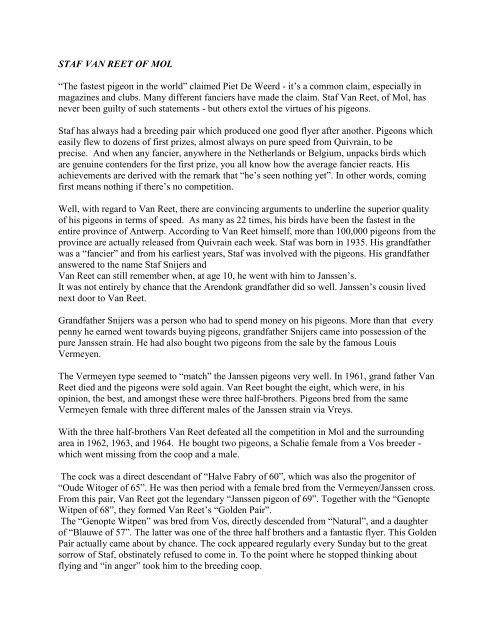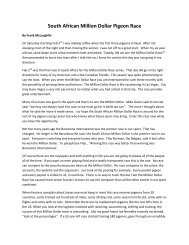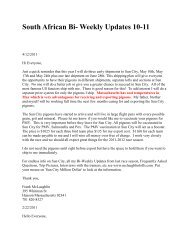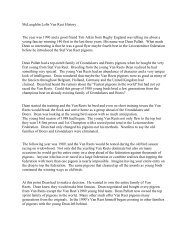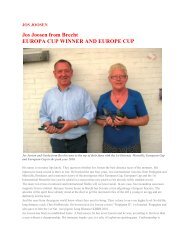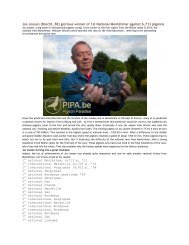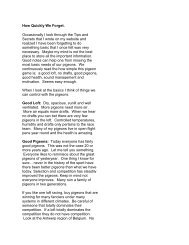STAF VAN REET OF MOL âThe fastest pigeon in ... - McLaughlin Lofts
STAF VAN REET OF MOL âThe fastest pigeon in ... - McLaughlin Lofts
STAF VAN REET OF MOL âThe fastest pigeon in ... - McLaughlin Lofts
- No tags were found...
You also want an ePaper? Increase the reach of your titles
YUMPU automatically turns print PDFs into web optimized ePapers that Google loves.
<strong>STAF</strong> <strong>VAN</strong> <strong>REET</strong> <strong>OF</strong> <strong>MOL</strong><br />
“The <strong>fastest</strong> <strong>pigeon</strong> <strong>in</strong> the world” claimed Piet De Weerd - it’s a common claim, especially <strong>in</strong><br />
magaz<strong>in</strong>es and clubs. Many different fanciers have made the claim. Staf Van Reet, of Mol, has<br />
never been guilty of such statements - but others extol the virtues of his <strong>pigeon</strong>s.<br />
Staf has always had a breed<strong>in</strong>g pair which produced one good flyer after another. Pigeons which<br />
easily flew to dozens of first prizes, almost always on pure speed from Quivra<strong>in</strong>, to be<br />
precise. And when any fancier, anywhere <strong>in</strong> the Netherlands or Belgium, unpacks birds which<br />
are genu<strong>in</strong>e contenders for the first prize, you all know how the average fancier reacts. His<br />
achievements are derived with the remark that “he’s seen noth<strong>in</strong>g yet”. In other words, com<strong>in</strong>g<br />
first means noth<strong>in</strong>g if there’s no competition.<br />
Well, with regard to Van Reet, there are conv<strong>in</strong>c<strong>in</strong>g arguments to underl<strong>in</strong>e the superior quality<br />
of his <strong>pigeon</strong>s <strong>in</strong> terms of speed. As many as 22 times, his birds have been the <strong>fastest</strong> <strong>in</strong> the<br />
entire prov<strong>in</strong>ce of Antwerp. Accord<strong>in</strong>g to Van Reet himself, more than 100,000 <strong>pigeon</strong>s from the<br />
prov<strong>in</strong>ce are actually released from Quivra<strong>in</strong> each week. Staf was born <strong>in</strong> 1935. His grandfather<br />
was a “fancier” and from his earliest years, Staf was <strong>in</strong>volved with the <strong>pigeon</strong>s. His grandfather<br />
answered to the name Staf Snijers and<br />
Van Reet can still remember when, at age 10, he went with him to Janssen’s.<br />
It was not entirely by chance that the Arendonk grandfather did so well. Janssen’s cous<strong>in</strong> lived<br />
next door to Van Reet.<br />
Grandfather Snijers was a person who had to spend money on his <strong>pigeon</strong>s. More than that every<br />
penny he earned went towards buy<strong>in</strong>g <strong>pigeon</strong>s, grandfather Snijers came <strong>in</strong>to possession of the<br />
pure Janssen stra<strong>in</strong>. He had also bought two <strong>pigeon</strong>s from the sale by the famous Louis<br />
Vermeyen.<br />
The Vermeyen type seemed to “match” the Janssen <strong>pigeon</strong>s very well. In 1961, grand father Van<br />
Reet died and the <strong>pigeon</strong>s were sold aga<strong>in</strong>. Van Reet bought the eight, which were, <strong>in</strong> his<br />
op<strong>in</strong>ion, the best, and amongst these were three half-brothers. Pigeons bred from the same<br />
Vermeyen female with three different males of the Janssen stra<strong>in</strong> via Vreys.<br />
With the three half-brothers Van Reet defeated all the competition <strong>in</strong> Mol and the surround<strong>in</strong>g<br />
area <strong>in</strong> 1962, 1963, and 1964. He bought two <strong>pigeon</strong>s, a Schalie female from a Vos breeder -<br />
which went miss<strong>in</strong>g from the coop and a male.<br />
The cock was a direct descendant of “Halve Fabry of 60”, which was also the progenitor of<br />
“Oude Witoger of 65”. He was then period with a female bred from the Vermeyen/Janssen cross.<br />
From this pair, Van Reet got the legendary “Janssen <strong>pigeon</strong> of 69”. Together with the “Genopte<br />
Witpen of 68”, they formed Van Reet’s “Golden Pair”.<br />
The “Genopte Witpen” was bred from Vos, directly descended from “Natural”, and a daughter<br />
of “Blauwe of 57”. The latter was one of the three half brothers and a fantastic flyer. This Golden<br />
Pair actually came about by chance. The cock appeared regularly every Sunday but to the great<br />
sorrow of Staf, obst<strong>in</strong>ately refused to come <strong>in</strong>. To the po<strong>in</strong>t where he stopped th<strong>in</strong>k<strong>in</strong>g about<br />
fly<strong>in</strong>g and “<strong>in</strong> anger” took him to the breed<strong>in</strong>g coop.
As a young bird, the female had already proved her quality by w<strong>in</strong>n<strong>in</strong>g 3 first prizes. The first<br />
young produced by the pair was the “Pr<strong>in</strong>z of 72”. As a young bird he never saw the basket and<br />
as a yearl<strong>in</strong>g was suddenly thrown <strong>in</strong> at the deep end. After a few failures, which can be<br />
expected from such an <strong>in</strong>experienced <strong>pigeon</strong>, he emerged <strong>in</strong> Quivra<strong>in</strong> as a flyer to beat them all.<br />
In this 132 km flight, he took 32 first prizes until clever Jan Grondelaers got w<strong>in</strong>d of the<br />
existence of the high flyer. In 1978, “Pr<strong>in</strong>z of 72” moved to Opglabbeck for a substantial sum,<br />
and the follow<strong>in</strong>g year showed what a connoisseur Grondelaers is. From Pr<strong>in</strong>z he bred his Stuka,<br />
famous <strong>in</strong> two ways: Stuka would race home to the coop so <strong>in</strong>credibly fast that on four occasions<br />
not even Jan himself or any of his watchers saw him arrive. Jan heard him each time without<br />
see<strong>in</strong>g a feather, just a thump on the floor of the coop. Another feature of Stuka (B-79-5185502)<br />
was that he won 12 first prizes. It is <strong>in</strong>terest<strong>in</strong>g to hear how Pr<strong>in</strong>z got his name.<br />
Borgmans from Turnhout, who at that time was rac<strong>in</strong>g through the Noyon flights like a<br />
hurricane, bought a female from Van Reet’s “Golden Pair”. She bred so well that Borgmans<br />
called her his “Pr<strong>in</strong>ses”. It struck Staf Van Reet as a suitable name, so the “Pr<strong>in</strong>sen” family was<br />
created by Van Reet. In the plural, as you can’t call a breed<strong>in</strong>g pair a “Golden Pair” if they only<br />
have one chick.<br />
In 1974, the Dikke Pr<strong>in</strong>s was born (B-74-6710998). He flew 26 first prizes.<br />
Still <strong>in</strong> 1974, the Witoog Pr<strong>in</strong>s was born (B-74-670895). He sat on the flight coop, but before his<br />
season began, broke one of his w<strong>in</strong>gs (fortunately, as it happens). He was of necessity rehoused<br />
<strong>in</strong> the breed<strong>in</strong>g coop and there produced several first prize w<strong>in</strong>ners, the most famous be<strong>in</strong>g the<br />
“Genopte Witpen of 76”. 1976 is the year <strong>in</strong> which the most spectacular son of the breed<strong>in</strong>g pair<br />
was born, Daniel (B-76-6635973). He flew no less than 57 firsts. The story is that a friend of<br />
Van Reet took him to the “De Reisduif” championships <strong>in</strong> his worst season. He came out of the<br />
box as the best speed <strong>pigeon</strong> <strong>in</strong> Belgium! Staf van Reet races his birds from the first week <strong>in</strong><br />
March to the<br />
last Sunday <strong>in</strong> July. Always alone. Then he lets them nest, and as soon as they have young, he<br />
flies them aga<strong>in</strong> - <strong>in</strong> the autumn. With young <strong>in</strong> the nest, the birds get home even faster,<br />
accord<strong>in</strong>g to Van Reet. This system naturally has its disadvantages. “Daniel” was left stand<strong>in</strong>g <strong>in</strong><br />
five start<strong>in</strong>g pens <strong>in</strong> the w<strong>in</strong>ter of 79/80. And understandably, Staf thought he would have to<br />
slow down with Daniel.<br />
On his first flight, <strong>in</strong> spite of his frequent victories, he only came <strong>in</strong> 4th. But Daniel, on his first<br />
competition <strong>in</strong> 1979, proved that the start<strong>in</strong>g pen isn’t that important if the quality’s there. He<br />
won with a four-m<strong>in</strong>ute lead. In June and July of that year, Daniel won the first prize 12 times <strong>in</strong><br />
succession. Staf says that with such pride that you know he’s not boast<strong>in</strong>g.<br />
The Kle<strong>in</strong>e Pr<strong>in</strong>s (B-76-6721975) is a brother of the phenomenon described. Staf lent him out<br />
<strong>in</strong>1982 to the German van Ravenste<strong>in</strong>. From him, <strong>in</strong> 1983, he bred a female who won 9 first<br />
prizes before go<strong>in</strong>g miss<strong>in</strong>g on a disastrous flight. In 1978, the “Pr<strong>in</strong>s of 78” was born from the<br />
Golden Pair (B-78-7722716). He flew only as a yearl<strong>in</strong>g and a two-year old. That didn’t prevent<br />
him tak<strong>in</strong>g 12 firsts. He was the last <strong>pigeon</strong> the breed<strong>in</strong>g pair produced. The cock ceased to be<br />
fertile, and the female stopped lay<strong>in</strong>g eggs. Both partners had given up at the same time. It is<br />
remarkable that from this pair, two totally different types of <strong>pigeon</strong>s came. One type resembled
the father (such as Daniel), the other was the image of the mother (such as Grondelaer’s<br />
Pr<strong>in</strong>s). That’s not important. Both were equally good flyers.<br />
The Van Reet <strong>pigeon</strong>s were able to keep up their lead. From 1972 to 1976, Staf paired up<br />
with Frans Verbruggen. Dur<strong>in</strong>g that time, they raced many times, and their successes were<br />
nearly all on speed alone. Which rem<strong>in</strong>ds us of the remarkable flight from Lirnoges <strong>in</strong> 1975.<br />
Eleven birds were entered, and ten were clocked <strong>in</strong> with<strong>in</strong> 11 m<strong>in</strong>utes. In the national results,<br />
“Van Reet of Mol” stole the show with 10 prizes start<strong>in</strong>g with 4th, 7th, and 9th overall. 31,000<br />
BF were bet on the flight. The ten <strong>pigeon</strong>s brought home BF 197,000.<br />
From this period, Van Reet also remembers the result at Dourant <strong>in</strong> the Zuiderkempen races. He<br />
won the top four. His greatest rival at the time - so he says- was none other than Janeke<br />
Wouters. In 1975, the Van Reet/Verbruggen comb<strong>in</strong>ation was crowned Champion of the East<br />
Antwerp area. Second was Mariman Raey and 3rd Gust Hofkens.<br />
Later van Reet was to put even more effort <strong>in</strong>to speed. As on the Sunday when he took part <strong>in</strong> a<br />
“match race” with just two birds: Daniel and Pr<strong>in</strong>s. They flew <strong>in</strong>to the coop together, 8 m<strong>in</strong>utes<br />
before the third <strong>pigeon</strong> <strong>in</strong> the race. Van Reet keeps his <strong>pigeon</strong>s <strong>in</strong> a bone-dry attic coop, which is<br />
never heated artificially. The females are always shown to the males before they are put <strong>in</strong>to the<br />
basket, but when they get home from the<br />
flight, there’s no system. Sometimes the mat<strong>in</strong>g is short, sometimes a male and female can look<br />
at each other for four hours. The coops are well ventilated and the males are free to sit on the<br />
coop.


